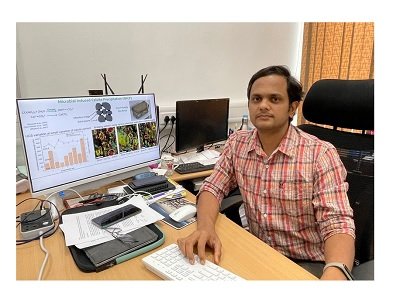Tuesday, 2 December 2025

IIT Mandi researchers are working towards developing sustainable techniques for soil stabilisation using a harmless bacteria called S. Pasteurii that hydrolyse urea to precipitate calcite. The process does not involve hazardous chemicals and natural resources can be used sustainably.
The findings of the research team have been recently published in the journal ‘Geotechnical and Geo-environmental Engineering of the American Society of Civil Engineers (ASCE)’.The research was led by Dr Kala Venkata Uday and co-authored by his MS scholar, Deepak Mori.
Speaking about his research, Dr Uday, Assistant Professor, School of Engineering, said, “Our study will be helpful in designing microbial methods to improve soil shear strength at the field scale, to protect the soil from erosion in hilly areas and during geo-disasters. We are also working on the microbe-driven production of construction material from quarry waste.”
The researchers used a harmless bacteria called S. Pasteurii that hydrolyse urea to precipitate calcite. The use of urea is particularly attractive because it does not involve hazardous chemicals and natural resources can be used sustainably. Their experimental setup consisted of a column of sand through which was percolated a mixture of the bacteria and cementing solution comprising urea, calcium chloride, nutrient broth, etc.
Explaining the research work, Mori, research scholar, IIT Mandi, said, “The Calcite Precipitation Efficiency (CPE) depends on a number of parameters including and not limited to the concentration of the cementing solution, its flow rate through the column, the supply rate, applied pore volume, and the sand grain characteristics. We set out to understand the effects of various parameters on the CPE.”
Since there were numerous parameters involved, researchers used the Taguchi method to analyse the effects of these various parameters on the strength enhancement of soil by MICP. This method involves the use of orthogonal arrays to organise the parameters affecting any process and the levels at which they should be varied. The Taguchi method enables the analysis of many influential parameters without the corresponding need for many experiments.